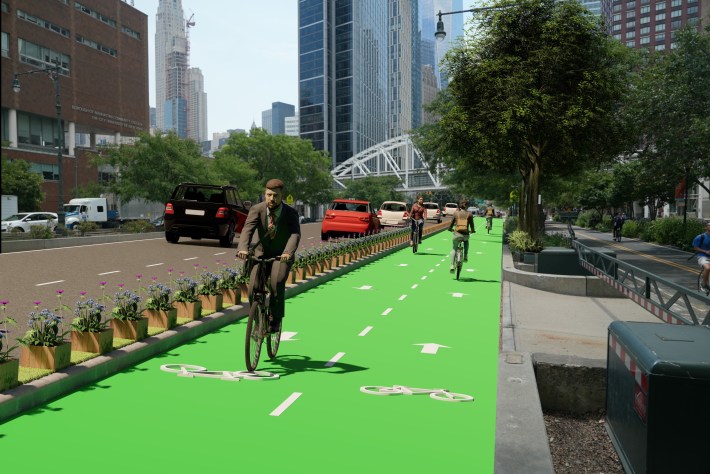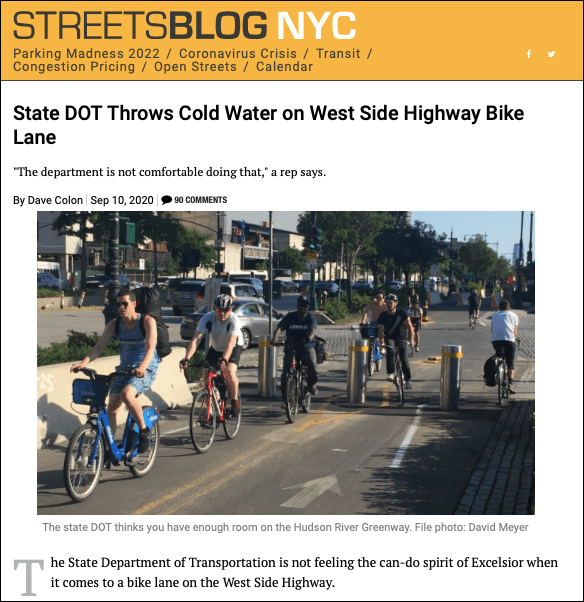It worked on the Brooklyn Bridge...
Manhattan Borough President Mark Levine is demanding that the state Department of Transportation begin the process of repurposing one lane of the West Side Highway and West Street to "create a two-way protected bike lane."
Levine said he is making the demand because "the current bike lane on the Hudson River Greenway ... has become one of the most heavily used bike paths in the country, particularly with the additional increase in the use of electric bicycles on the lane."
Levine sent his demand in a letter to state DOT Commissioner Therese Dominguez on Monday, but he'll be joined by a plethora of elected officials, including members of the Council, community board officials and others at a 10 a.m. press conference at the corner of Chambers and West streets. (The demand is to the state rather than the city DOT because West Street, Route 9A, is a state highway, but the letter was also addressed to city DOT Commissioner Ydanis Rodriguez.)

"The Hudson River Greenway is one of the most heavily used bike paths in the country," Levine wrote. "It offers an exceptional opportunity for commuters wishing to abandon traditional modes of transportation in favor of a sustainable, healthy, and efficient alternative. However, in recent years, congestion on the Greenway, both between cyclists but also between cyclists and pedestrians, has worsened significantly. ... Compounding this issue is an additional increase in electric bicycles use. ... Installing a protected bike lane on Route 9A would solve both issues by easing congestion on the current path while creating a legal space for cyclists using electric bicycles, many of whom are immigrant, delivery workers who should not be ticketed for trying to work and travel."
The press conference will attract a large number of local electeds because, for years, many of those same elected officials and their predecessors on the West Side have called on the state DOT to shrink the roadway for cars and add space for cyclists. But those efforts get a shot in the arm at the dawn of the pandemic in 2020 when all three downtown community boards and the local lawmakers pushed again for a transformation of a roadway that suddenly had virtually no car traffic on its six north-south lanes, yet was booming with north- and southbound cyclists crammed into just one lane of the Hudson River Greenway, the busiest bike lane in North America.
Manhattan CBs 1, 2 & 4, & Hudson River Park Ad. Council all on record asking for this in 2020 & all local electeds. We wanted it when every other city was transforming their streetscapes but: Cuomo. Grateful @MBPMarkLevine is LEADING on this! @Chekpeds https://t.co/fve5EHcXip
— Jeffrey LeFrancois (@jlef423) August 1, 2022
"We organized community boards 1, 2 and 4 and sent a letter to state DOT from nine local electeds," said Jeffrey LeFrancois, now the chairman of Community Board 4 in Hells Kitchen and Chelsea. "Initially it was pandemic-related. The highway was carless at the time, yet the greenway was busy. The idea was to take the lane during the pandemic so people could make the adjustment before things opened up again and all the cars returned."
Community Board 1, in fact, had voted 41-3 in May of that year to support the change. The other boards were also, well, on board.
That support led to an Aug. 22, 2020 letter from State Sens. Brad Hoylman, Robert Jackson and Brian Kavanagh, Assembly Members Deborah Glick, Richard Gottfried and Linda Rosenthal, plus Manhattan Borough President Gale Brewer and Council Members Margaret Chin and Corey Johnson to the state.

"Usage of the Greenway has increased to the point where the conflict between pedestrians, skateboarders, rollerbladers and cyclists has led to deeper concerns about safety," the letter stated. "A solution to this problem has been proposed by the Hudson River Park Trust Advisory Council and Manhattan Community Boards 1, 2 and 4: to expand the Greenway to include the westernmost lane of Route 9A from West 54th Street to the Battery. This new lane would absorb all southbound bicycle traffic with northbound bicycle traffic using the Greenway space. The current divider between the Greenway and Route 9A would separate opposing bicycle traffic, reducing collisions."
Such an arrangement, the pols said, "would be a model for 21st century transit planning for New York City: acknowledging the reality that people are bicycling more while encouraging this more environmentally friendly mode of transportation."
LeFrancois said the letter was ignored.
"Cuomo was being Cuomo," LeFrancois said. "Meanwhile, cities around the world eclipsed us, including Boston, Paris and London made these pandemic-era changes and are better cities as a result."
Levine's rendering shows that he supports same solution proposed two years ago, but LeFrancois said that state officials could also add the new bike lane on the easternmost side of the roadway.
"I don't know what is better because I'm not an engineer," LeFrancois said. "But I do know that there is a lot of federal money tied to pedestrian and cyclist improvements, so let's tap the infrastructure bill."
LeFrancois pointed out that regardless of the configuration, more space is needed for cyclists and e-cyclists.
"One lane could be for regular bikes and the other for new forms of micro-mobility," he said, citing the increasing conflict as existing bike lanes are increasingly filed with cyclists, e-bike riders, moped users, scooter users and one-wheel riders [PDF]. "It's an abject failure of city and state policy that there is a daily fight among people using forms of green mobility that technology has brought us. We need to embrace micro-mobility instead of pitting neighbors against each other for making a greener decision than using a car. We should be providing safe ways to get around town."
A spokesman for the state DOT declined to comment on Levine's coming press conference, but said the agency "is in receipt of the letter and [is] reviewing it."
In the past, when Streetsblog has asked about efforts to give cyclists more space on West Street, the agency has been dismissive. In September 2020, an agency official told local lawmakers, "We have a few concerns with removing a lane on the travel way on the southbound side."
A year earlier, then-state DOT Regional Traffic Safety and Mobility Director Adam Levine could barely stifle his contempt when Streetsblog asked if he and Gov. Cuomo would consider reallocating a lane from drivers for cyclists and pedestrians, who are the majority of people who cross or bike or walk along the West Side Highway.
“To remove a lane would congest the road,” he said, citing no evidence.






